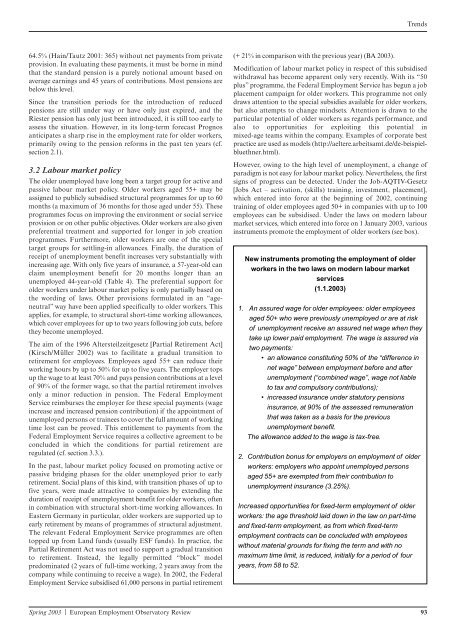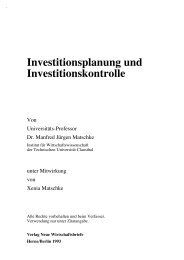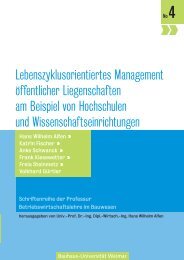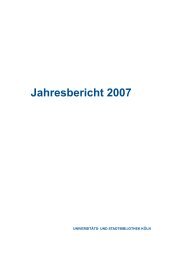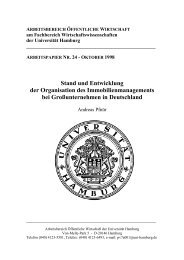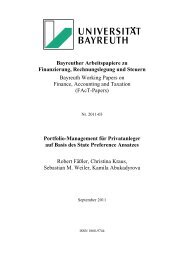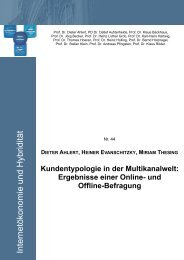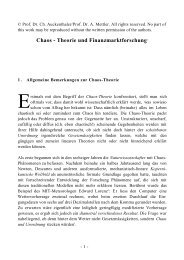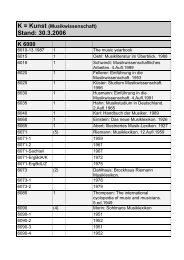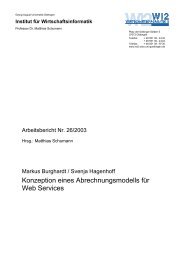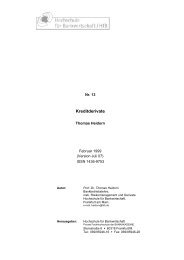FRANCE The
FRANCE The
FRANCE The
You also want an ePaper? Increase the reach of your titles
YUMPU automatically turns print PDFs into web optimized ePapers that Google loves.
64.5% (Hain/Tautz 2001: 365) without net payments from private<br />
provision. In evaluating these payments, it must be borne in mind<br />
that the standard pension is a purely notional amount based on<br />
average earnings and 45 years of contributions. Most pensions are<br />
below this level.<br />
Since the transition periods for the introduction of reduced<br />
pensions are still under way or have only just expired, and the<br />
Riester pension has only just been introduced, it is still too early to<br />
assess the situation. However, in its long-term forecast Prognos<br />
anticipates a sharp rise in the employment rate for older workers,<br />
primarily owing to the pension reforms in the past ten years (cf.<br />
section 2.1).<br />
3.2 Labour market policy<br />
<strong>The</strong> older unemployed have long been a target group for active and<br />
passive labour market policy. Older workers aged 55+ may be<br />
assigned to publicly subsidised structural programmes for up to 60<br />
months (a maximum of 36 months for those aged under 55). <strong>The</strong>se<br />
programmes focus on improving the environment or social service<br />
provision or on other public objectives. Older workers are also given<br />
preferential treatment and supported for longer in job creation<br />
programmes. Furthermore, older workers are one of the special<br />
target groups for settling-in allowances. Finally, the duration of<br />
receipt of unemployment benefit increases very substantially with<br />
increasing age. With only five years of insurance, a 57-year-old can<br />
claim unemployment benefit for 20 months longer than an<br />
unemployed 44-year-old (Table 4). <strong>The</strong> preferential support for<br />
older workers under labour market policy is only partially based on<br />
the wording of laws. Other provisions formulated in an “ageneutral”<br />
way have been applied specifically to older workers. This<br />
applies, for example, to structural short-time working allowances,<br />
which cover employees for up to two years following job cuts, before<br />
they become unemployed.<br />
<strong>The</strong> aim of the 1996 Altersteilzeitgesetz [Partial Retirement Act]<br />
(Kirsch/Müller 2002) was to facilitate a gradual transition to<br />
retirement for employees. Employees aged 55+ can reduce their<br />
working hours by up to 50% for up to five years. <strong>The</strong> employer tops<br />
up the wage to at least 70% and pays pension contributions at a level<br />
of 90% of the former wage, so that the partial retirement involves<br />
only a minor reduction in pension. <strong>The</strong> Federal Employment<br />
Service reimburses the employer for these special payments (wage<br />
increase and increased pension contribution) if the appointment of<br />
unemployed persons or trainees to cover the full amount of working<br />
time lost can be proved. This entitlement to payments from the<br />
Federal Employment Service requires a collective agreement to be<br />
concluded in which the conditions for partial retirement are<br />
regulated (cf. section 3.3.).<br />
In the past, labour market policy focused on promoting active or<br />
passive bridging phases for the older unemployed prior to early<br />
retirement. Social plans of this kind, with transition phases of up to<br />
five years, were made attractive to companies by extending the<br />
duration of receipt of unemployment benefit for older workers, often<br />
in combination with structural short-time working allowances. In<br />
Eastern Germany in particular, older workers are supported up to<br />
early retirement by means of programmes of structural adjustment.<br />
<strong>The</strong> relevant Federal Employment Service programmes are often<br />
topped up from Land funds (usually ESF funds). In practice, the<br />
Partial Retirement Act was not used to support a gradual transition<br />
to retirement. Instead, the legally permitted “block” model<br />
predominated (2 years of full-time working, 2 years away from the<br />
company while continuing to receive a wage). In 2002, the Federal<br />
Employment Service subsidised 61,000 persons in partial retirement<br />
Spring 2003 | European Employment Observatory Review 93<br />
Trends<br />
(+ 21% in comparison with the previous year) (BA 2003).<br />
Modification of labour market policy in respect of this subsidised<br />
withdrawal has become apparent only very recently. With its “50<br />
plus” programme, the Federal Employment Service has begun a job<br />
placement campaign for older workers. This programme not only<br />
draws attention to the special subsidies available for older workers,<br />
but also attempts to change mindsets. Attention is drawn to the<br />
particular potential of older workers as regards performance, and<br />
also to opportunities for exploiting this potential in<br />
mixed-age teams within the company. Examples of corporate best<br />
practice are used as models (http://aeltere.arbeitsamt.de/de-beispielbluethner.html).<br />
However, owing to the high level of unemployment, a change of<br />
paradigm is not easy for labour market policy. Nevertheless, the first<br />
signs of progress can be detected. Under the Job-AQTIV-Gesetz<br />
[Jobs Act – activation, (skills) training, investment, placement],<br />
which entered into force at the beginning of 2002, continuing<br />
training of older employees aged 50+ in companies with up to 100<br />
employees can be subsidised. Under the laws on modern labour<br />
market services, which entered into force on 1 January 2003, various<br />
instruments promote the employment of older workers (see box).<br />
New instruments promoting the employment of older<br />
workers in the two laws on modern labour market<br />
services<br />
(1.1.2003)<br />
1. An assured wage for older employees: older employees<br />
aged 50+ who were previously unemployed or are at risk<br />
of unemployment receive an assured net wage when they<br />
take up lower paid employment. <strong>The</strong> wage is assured via<br />
two payments:<br />
• an allowance constituting 50% of the “difference in<br />
net wage” between employment before and after<br />
unemployment (“combined wage”, wage not liable<br />
to tax and compulsory contributions);<br />
• increased insurance under statutory pensions<br />
insurance, at 90% of the assessed remuneration<br />
that was taken as a basis for the previous<br />
unemployment benefit.<br />
<strong>The</strong> allowance added to the wage is tax-free.<br />
2. Contribution bonus for employers on employment of older<br />
workers: employers who appoint unemployed persons<br />
aged 55+ are exempted from their contribution to<br />
unemployment insurance (3.25%).<br />
Increased opportunities for fixed-term employment of older<br />
workers: the age threshold laid down in the law on part-time<br />
and fixed-term employment, as from which fixed-term<br />
employment contracts can be concluded with employees<br />
without material grounds for fixing the term and with no<br />
maximum time limit, is reduced, initially for a period of four<br />
years, from 58 to 52.


